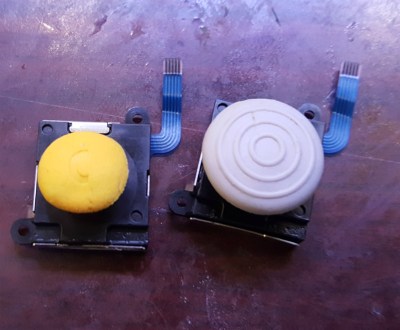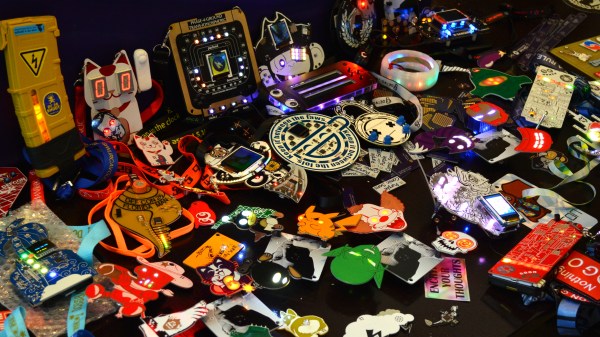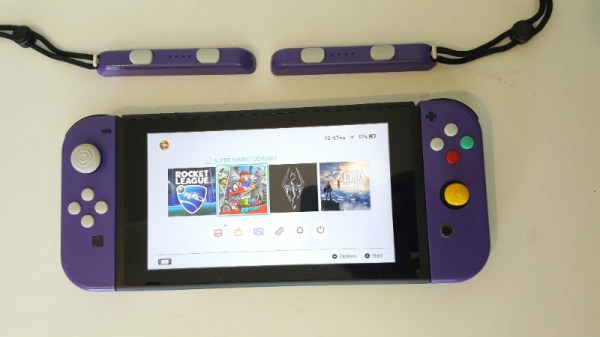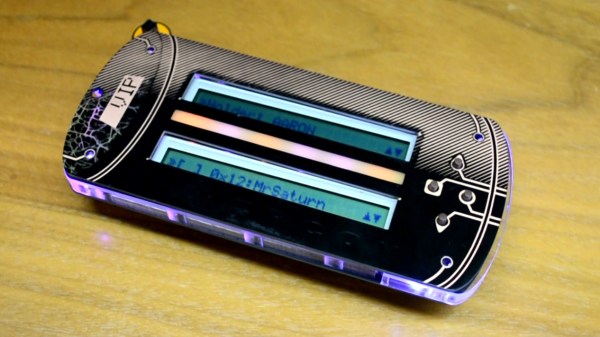Two or three years back you would see a handful of really interesting unofficial badges at DEF CON. Now, there’s a deluge of clever, beautiful, and well executed badges. Last weekend I tried to see every badge and meet every badge maker. Normally, I would publish one megapost to show off everything I had seen, but this year I’m splitting it into volumes. Join me after the break for the first upload of the incredible badges of DC26!
Get Nostalgic With These GameCube Themed Joy-Cons
There are a lot of good reasons to think fondly of the Nintendo GameCube. Metroid Prime and Rogue Leader knocked it out of the park. The Game Boy Player was cool. There’s even something to be said for having a convenient carrying handle on a system designed for couch multiplayer. But if you ask anyone who played Nintendo’s sixth generation console what part they missed the least, it would probably be the controller. With all the visual flair of a Little Tikes playset and ergonomics designed for an octopus, it’s a controller that works well for first-party Nintendo titles and little else.
 So it’s probably for the best that these Switch Joy-Cons created by [Madmorda] focus on recreating the aesthetics of the GameCube controller for Nintendo’s latest money-printing machine rather than its feel. With a surprising amount of work required to create them, these definitely count as a labor of love by someone who yearns for the days when gaming was more…cubic.
So it’s probably for the best that these Switch Joy-Cons created by [Madmorda] focus on recreating the aesthetics of the GameCube controller for Nintendo’s latest money-printing machine rather than its feel. With a surprising amount of work required to create them, these definitely count as a labor of love by someone who yearns for the days when gaming was more…cubic.
To start with, nobody makes Joy-Con cases in that signature GameCube purple so [Madmorda] had to paint them herself. The longevity of a painted controller is somewhat debatable, but the finish certainly looks fantastic right now.
For the left analog stick [Madmorda] was able to use the cap from a real GameCube controller, which fit perfectly. Apparently, Nintendo has been pretty happy with their analog stick sizing decisions for the last two decades or so. The right analog stick was another story, however, and she had to cut the shaft down to size with a Dremel to get the cap to fit.
Finally, molds were made of the original face buttons, which were then used to cast new buttons with colored resin to match the GameCube color scheme. Since the original Switch buttons don’t have indented lettering to get picked up by the mold, she had to laser etch them. This little detail goes a long way to selling the overall look.
The final result looks great, and compared to previous attempts we’ve seen to bring some of that early 2000’s Nintendo style to the Switch, this one is certainly less destructive. Check them out in action after the break!
Continue reading “Get Nostalgic With These GameCube Themed Joy-Cons”
Teardown: Queercon 15 Badge (and The Game Hidden Within)
Queercon is a conference within a conference. Taking place within DEF CON, Queercon is a social network of LGBT hackers that gathers each year to host events, talks, and a kickin’ pool party. Since 2012 they have also been building electronic badges as part of the fun and I can vouch that they’re contenders for most creative badge design every single year.
A total of 450 electronic badges were made this year, and the aesthetic is as close to a polished consumer product as I have ever seen in a badge, yet they also retain the charm and feel of unique electronics built for hardware geeks. With wireless communication that delivers a complex and clever game to the badges, the designers are encouraging interaction between people (not just between badges). I had the chance to do a teardown of one of these glorious badges, and also gathered quite a bit of info on the puzzles within during Friday’s badge talk in the QC suite.
Join me after the break as I tear down the Queercon 15 hardware badge. If you haven’t yet looked over my review of the official DC26 badge, check that out as well!
Continue reading “Teardown: Queercon 15 Badge (and The Game Hidden Within)”
More Suspension Than Necessary
The triangular frame of a traditional mountain bike needs to be the most rigid structure, and a triangle can be a very sturdy shape. So [Colin Furze] throws a spanner in the works, or, in this case, a bunch of springs. The video is below the break, but please try to imagine you are at a party, eyeballing some delicious salsa, yet instead of a tortilla chip, someone hands you a slab of gelatin dessert. The bike is kind of like that.
Anyone who has purchased springs knows there are a lot of options and terminology, such as Newton meters of force, extension, compression, and buckling. There is a learning curve to springs so a simple statement, for example “I want to make a bicycle of springs,” doesn’t have any easy answers. It is a lot like saying, “I want to make a microprocessor out of transistors“. This project starts with springs roughly the diameter of the old bike tubes, and it is a colossal failure. Try using cooked spaghetti noodles to make a bridge.
The first set of custom springs are not up to the task, but the third round produces something rideable. The result seems to be a ridiculous way to exercise your abs and is approximately a training unicycle mated with a boat anchor.
What makes this a hack? The video is as entertaining as anything [Colin] has made, but that does not make it a hack by itself. The hack is that someone asked a ridiculous question, possibly within reach of alcohol, and the answer came by building the stupid thing. A spring-bicycle could have been simulated six ways from Sunday on an old Android phone, but the adventure extracted was worth the cost of doing it in real life.
DSO Nano 3 Review: A 20 MHz Pocket ‘Scope For Not A Lot
The oscilloscope is an essential tool of any electronics bench, and it is also an instrument whose capabilities have expanded exponentially over the decades. Your entirely analogue CRT ‘scope of a few decades ago has now been supplanted by a digital device that takes on many of the functions of both an expensive multimeter a frequency counter, and more. At the top end of the market the sky is the limit when it comes to budget, and the lower end stretches down to low-bandwidth devices based upon commodity microcontrollers for near-pocket-money prices.
These super-cheap ‘scopes are usually sold as kits, and despite their very low bandwidth are surprisingly capable instruments with a useful feature set due to well-written software. I reviewed a typical model last year, and came away lamenting its lack of an internal battery and a decent quality probe. If only someone would produce an inexpensive miniature ‘scope with a decent bandwidth, decent probe, and an internal battery!
As it happens, I didn’t have long to wait for my wish to be satisfied, with news of the release of the DSO Nano 3. Let’s see what you can do with a portable scope for less than $50.
Continue reading “DSO Nano 3 Review: A 20 MHz Pocket ‘Scope For Not A Lot”
Video Review: AND!XOR DEF CON 26 Badge
The AND!XOR team have somehow managed to outdo themselves once again this year. Their newest unofficial hardware badge for DEF CON 26 just arrived. It’s a delightful creation in hardware, software, and the interactive challenges built into both.
They call this the “Wild West of IoT”, a name that draws from the aesthetic as well as the badge-to-badge communications features. Built on the ESP32-WROVER module which brings both WiFi and Bluetooth to the party, the badges are designed to form a wireless botnet at the conference. Anyone with a badge can work to advance their level and take more and more control of the botnet as they do.
Check out the video overview and then join me below for a deeper dive into all this badge has to offer.
Hands On With Python 3.7: What’s New In The Latest Release
Used for general purpose programming, data science, website backends, GUIs, and pretty much everything else; the first programming language for many, and claimed to be the fastest growing in the world, is of course Python. The newest version 3.7.0 has just recently been released.
Naturally any release of Python, no matter how small, undergoes meticulous planning and design before any development is started at all. In fact, you can read the PEP (Python Enhancement Proposal) for Python 3.7, which was created back in 2016.
What’s new in 3.7? Why should you upgrade? Is there anything new that’s actually useful? I’ll answer these questions for you by walking through some examples of the new features. Whilst there’s not much in this release that will make a difference to the Python beginner, there’s plenty of small changes for seasoned coders and a few headline features you’ll want to know about.
Continue reading “Hands On With Python 3.7: What’s New In The Latest Release”


















